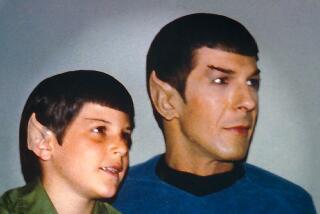From the Archives: ‘Star Trek’ deftly mind-melds Gene Roddenberry’s vision with J.J. Abrams’ storytelling
- Share via
Here’s a challenge: How do you implant a potentially lethal alien organism into a body that desperately needs the help but might die if things don’t go just right? No, it’s not the plot of an old “Star Trek” episode, it’s the back story of the new “Star Trek” motion picture.
It’s no secret that director J.J. Abrams and his writers of choice, Roberto Orci and Alex Kurtzman, were brought in by Paramount to reformulate the venerable space opera franchise that was viewed as requiring a jolt of energy. What was not often focused on was that the differences between what they wanted to do and what had gone before made this a perilous endeavor.
So it is pleasant to report that though it’s not perfect, the reconstituted “Star Trek” is successful enough for everyone to breathe a sigh of relief. Though it has its over-caffeinated aspects and its missteps, this “Star Trek” has in general bridged the gap between the old and the new with alacrity and purpose.
Part of the reason for the film’s success was its decision to position itself as “Star Trek: The Young Years.” Back we go to the maiden voyage of the starship Enterprise, to the first meetings of future Capt. James T. Kirk (Chris Pine) and his baby-faced crew: Spock (Zachary Quinto), Uhura (Zoe Saldana), “Bones” McCoy (Karl Urban), “Scotty” (Simon Pegg), Chekov (Anton Yelchin) and Sulu (John Cho).
In addition to using capable actors who were not marquee names and working in a satisfying role for Leonard Nimoy as Spock Prime (you’ll have to see the movie if you want that explained), Abrams and company have come up with a serviceable “the Earth must be saved” plot. Involved are such science fiction staples as alternate realities and black holes as well as a tattooed Romulan evildoer named Captain Nero (a capable Eric Bana) who looks like the frontman for a nasty rock band from the north of England.
The plot is also the frame on which numerous action sequences are hung, big ticket items that emphasize stunts, special effects and all the other goodies that all the other franchise movies have. As a known invigorator of pop culture enterprises (“Mission: Impossible III”), Abrams has not shied away from that particular mission.
The difficulty is that Abrams’ mandate to a certain extent conflicts with the “Star Trek” ethos, a clash that can’t be easily ignored. Despite all the glib talk about how moribund the franchise has become, any TV series that spawned 10 preveious motion pictures and several small-screen series has the kind of deep appeal that Hollywood ignores at its peril.
And being true to the Trekker fan base means more than a part for Nimoy, an adroit demonstration of the Vulcan nerve pinch and lines of dialogue like “our gravitational sensors are going crazy.” It means embracing a humanistic, utopian world view that never depended on elaborate special effects for its effectiveness. Given the differences between the “Star Trek” ethos created by Gene Roddenberry and the one that Abrams and company represent, what’s surprising is not that the new film sometimes misses but rather how many hits there actually are.
The place where the Vulcan mind meld between these two sensibilities is at its best is in “Star Trek’s” opening sequence, a kind of prequel set on an earlier starship, the Kelvin. It offers the first glimpse of the Narada, the enormous Romulan ship that looks like a monstrous insect, and a sequence that immediately goes for broke by combining a fierce and unexpected enemy attack, a chaotic, frenzied evacuation and a baby about to be born into peril and sadness all in the same breathless few minutes.
After that, “Star Trek” catches its breath for perhaps too long, showing us Spock and Kirk as young boys and then young men and their varying paths to the Federation fleet. Kirk’s route is the more cliched, as his hell-raising youth leads to barroom brawls and a life-changing interview with Capt. Christopher Pike (a strong Bruce Greenwood), who wonders aloud why young Kirk was “the only genius-level repeat offender in the Midwest.”
After “Star Trek” finally gets everyone on the Enterprise, it tries to make up for so much down time. Though it has to go through the pro forma introductions of all those more or less beloved characters -- something which hampered the first “X-Men” movie as well -- “Trek” then goes into high gear, throwing all kinds of action and incidents at us until undernourished threatens to become overstuffed.
What saves the film, finally, is Abrams’ playful instinct for popular entertainment, the same instinct that turns unexpected performers like Winona Ryder (as Spock’s mother) and Tyler Perry (as super-serious Starfleet Adm. Richard Barnett) into supporting players in his epic. Any director who can find room for them and the Vulcan salute in the same motion picture is operating under a pretty big tent, which is just what summer blockbusters need if they are to live long and prosper.
More to Read
Only good movies
Get the Indie Focus newsletter, Mark Olsen's weekly guide to the world of cinema.
You may occasionally receive promotional content from the Los Angeles Times.











